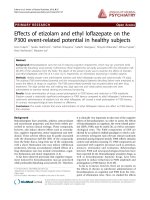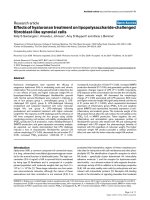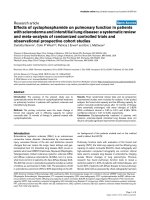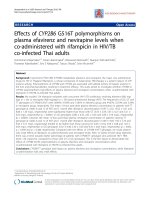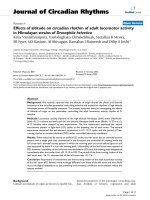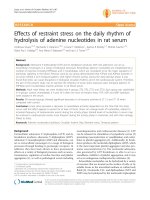Báo cáo y học: " Effects of restraint stress on the daily rhythm of hydrolysis of adenine nucleotides in rat serum" potx
Bạn đang xem bản rút gọn của tài liệu. Xem và tải ngay bản đầy đủ của tài liệu tại đây (368.54 KB, 6 trang )
RESEA R C H Open Access
Effects of restraint stress on the daily rhythm of
hydrolysis of adenine nucleotides in rat serum
Andressa Souza
1,3,4†
, Bernardo C Detanico
1,3,4†
, Liciane F Medeiros
1
, Joanna R Rozisky
1,3
, Wolnei Caumo
1,3,4
,
Maria Paz L Hidalgo
3,4
, Ana Maria O Battastini
2,3
and Iraci LS Torres
1,3,4*
Abstract
Background: Adenosine 5-triphosphate (ATP) and its breakdown products ADP and adenosine can act as
extracellular messengers in a range of biological processes. Extracellular adenine nucleotides are metabolized by a
number of enzymes including NTPDases and 5’-nucleotidase, which are considered to be the major regulators of
purinergic signaling in the blood. Previous work by our group demonstrated that ATPase and ADPase activities in
rat serum exhibit a 24-h temporal pattern, with higher enzyme activity during the dark (activity) phase. It was
found that stress can cause disruptions in biological circadian rhythms and in the cardiovascular system. Therefore,
the aim of the present study was to examine the influence of acute stress exposure upon temporal patterns of
NTPDase and 5-nucleotidase enzyme activities in rat blood serum.
Methods: Adult male Wistar rats were divided into 4 groups: ZT0, ZT6, ZT12 and ZT18. Each group was subdivided
in 4 groups: control, immediately, 6 h and 24 h after one hour of restraint stress. ATP, ADP and AMP hydrolysis
were assayed in the serum.
Results: All stressed groups showed significant decreases in all enzyme activities at ZT 12 and ZT 18 when
compared with control.
Conclusion: Acute stress provo kes a decrease in nucleotidase activities dependent on the time that this stress
occurs and this effect appears to persist for at least 24 hours. Stress can change levels of nucleotides, related to
increased frequency of cardiovascular events during the activity phase. Altered levels of nucleotides in serum may
be involved in cardiovascular events more frequent during the activity phase in mammals, and with their etiology
linked to stress.
Keywords: Adenine nucleotides hydrolysis, Circadian rhythm, Rats , Restraint stress, Temporal pattern
Background
Extracellular adenosine 5’-triphosphate (ATP) and its
breakdown produc ts, adenosine 5’ -diphospha te (ADP),
adenosine 5’-monophosphate (AMP) and adenosine, can
act as extracellular messengers in a range of biological
processes through binding to purinergic receptors. In
addition, they have been shown to have pronounced
effects on a variety of biological processes such as neuro-
transmission, regulation of cardiac function and platelet
aggregation [1], as well as pathological events including
neurodegenerative and cardiovascular diseases [2]. ATP
can be released via stimulation of sympathetic nerves [3]
promoting vasoconstriction or vasodilatation, and contri-
butes to platelet aggregation [4]. Additionally, its break-
down produces the nucleotide diphosphate (ADP), which
is the most important platelet aggregator and also pro-
motes vasoconstriction [5]. The nucleoside adenosine,
also generated by ATP breakdown, is able to act as a
vasodilator, inhibitor of platelet aggregation, and it may
act as an endogenous cardioprotective substance [4].
Extracellular nucleotides can be hydrolyzed by a variety
of enzymes that are located on the surface of cells, or by
soluble forms in the interstitial medium or within body
fluids [6]. Nucleoside 5’tri- and diphosphates (NTP and
NDP) may be hydrolyzed by the nucleoside triphosphate
* Correspondence:
† Contributed equally
1
Laboratório de Cronobiologia Experimental, Departamento de
Farmacologia, Instituto de Ciências Básicas da Saúde, Universidade Federal
do Rio Grande do Sul, Porto Alegre, RS, 90050-170, Brazil
Full list of author information is available at the end of the article
Souza et al. Journal of Circadian Rhythms 2011, 9:7
/>© 2011 Souza et al; licensee BioMed Central Ltd. This is an Open Access article distributed under the terms of the Creative Commons
Attribution License ( which p ermits unrestricted use, distribution, and reproduction in
any medium, provided the original wor k is properly cited.
diphosphohydrolase enzym e family (NTPDases), nucleo-
tide phosphate inhibitor/phosphodiesterase family (NPP),
alkaline phosphatases and ecto-5’-nucleotidase [6]. Eight
different NTPDases have so far been described:
NTPDases 1, 2, 3 and 8 are expressed on the cell surface
with a catalytic site fa cing to the extracellular space,
while NTPDases 4, 5 6, and are entirely intracellular [6].
The ecto-5’-nucle otidase is attached to the cell surface
and may occur also in a soluble form via cleavage of its
glycosyl-phosphati dylinositol (GPI)-anchor by phospholi-
pase C [6]. These nucleotidas es, together with 5’-nucleo-
tidase, control the availability of ligands (ATP, ADP and
aden osine) for both nucleotide and nucleoside receptors,
and consequently, the duration and extent of rece ptor
activation [4]. Previous work by our group demonstrated
that ATPase and ADPase activities exhibit a 24-hour
temporal pattern in rat blood serum, with activities
increased during the dark period while AMPase activity
did not display circadian variation [7].
Circadian organization is important to enable an
organism to maintain equilibrium in response to the
daily changes in the external environmental and prepare
accordingly [8]. In mammals, a number of circadian pat-
terns (~24-h) have been described, including the timing
of endocrine hormone secretion (e.g. melatonin, corticos-
terone or cortisol, adrenocorticotropic hormone), body
temperature, respiratory ra te, heart rate, blood pressure
and effect of drugs [9,10].
Some studies have demonstrated the influence of stress
in modulating the purinergic system. Mild stress, such as
a mild foot shock, is enough to promote specific changes
in the hydrolysis of ATP and ADP in some tissues such
as cerebral cortex [11]. Moreover, changes in the activ-
ities of enzymes involved in nucleotide hydrolysis have
also been reported in spinal cord and blood serum after
repeated restraint stress[12,13] and after acute restraint
stress [14].
Considering that the temporal variation of nucleotidase
activities [7] may be of great importance in regulating the
cardiovascular system, and that acute stress disrupts both
circadian rhythms [15,16] and the function of the cardio-
vascular system [17], we i nvestigated the effects of acute
restraint stress on the 24-h temporal pattern of ATPase,
ADPase and AMPase enzyme activities in rat blood
serum. More specifically, in this study we assessed the
relationship between the time of day at which the stress is
applied and the temporal course of the so luble nucleoti-
dase activities after acute stress.
Methods
Animals
A total of 98 naive adult male Wistar rats (50-70 days
old; 190-240 g weight) were u sed. The animals were
maintained under a standard 12/12-h light/dark cycle
[lights on at 07:00 h, Zeitgeber time (ZT) 0, and lights off
at 19:00 h, ZT 12], in a controlled environment (22 ±
2°C), with rat chow and water a d libitum. The Zeitgeber
time was used as a reference to detect the rhythmicity of
the variables under study. The experimental protocol was
approved by an Institutional Review Board for use in ani-
mals with procedures in accordance with the National
Institutes of Health Guide for Care and Use of Labora-
tory Animals (Publication No. 85-23, revised 1985),
the UK Animals Scientific Procedures Act 1986 and
the European Community’ s Council Directive of 24
November 1986 (86/609/EEC).
Experimental design
Rats were habituated to the vivarium for 2 weeks befor e
the beginning of the experiment. On the day of the
experiment, the animals were divided into 4 groups
according to time of day (ZT 0, ZT 6, ZT 12, and ZT
18) and each of these was subdivided into 4 groups
according to time of death (control group, 0 hours, 6
hours, and 24 hours after acute stress) (see Figure 1).
The rats were submit ted to the model of acute restraint
stress described by Torres et al. [12]. Trunk blood was
drawn and blood samples were centrifuged in plastic
tubes for 5 min at 5000 × g at room temperature [18].
Serum was obtained and frozen at -20°C until the
enzyme assays were performed. To verify that enzymatic
activity is not altered by freezing of the samples, we
conducted a pre-study comparing frozen samples and
samples obtained after decapitation of animals on the
same day of the enzymatic assay. Blood samples were
centrifuged in plastic tubes for 5 min at 3000× g at
room temperature, the serum was separated, and it was
used in the enzyme assay immediately (see below). We
found no statistically significant difference between fro-
zen and fresh samples.
Enzyme assay
ATP, ADP, and AMP hydrolysis were analyzed using a
modification of the method described by Oses and collea-
gues [19], differing only in number of duplicates, where
we used triplicate numbe r of samples. The reaction mix-
ture, containing 0.5 to 1.0 mg serum protein in 112.5 mM
Tris-HCl, pH 8.0, was preincubated for 10 min to equili-
brate the mixture. The reaction was started by the addition
of ATP or ADP (final concentration of 3.0 mM) and the
mixture was incubated at 37°C in a final volume of 200 μl,
for 40 m in. The reaction was stopped by the addition of
200 μl 10% trichloroacetic acid (TCA). All samples were
centrifuged at 5000 × g for 5 min to eliminate precipitated
protein and the supernatant was used for the colorimetric
assay. The inorganic phosphate (Pi) released was measured
by the Malachite green method [20]. AMP hydrolysis was
quantified essentiall y as described above for ATP a nd
Souza et al. Journal of Circadian Rhythms 2011, 9:7
/>Page 2 of 6
ADP hydrolysis. The reaction mixture, containing 3.0 mM
AMP as substrate in 100 mM Tris-HCl, pH 7.5, was incu-
bated with 0.5 to 1.0 mg serum protein at 37°C in a final
volume of 200 μl. All other procedures were the same as
described above for ATP and ADP hydrolysis. For all
enzyme assays, incubation times, substrate and protein
concentrations were chosen in order to ensure the linear-
ity of the reactions. All samples were run in triplicate. In
order to correct for non-enzymatic hydrolysis, we per-
formed controls by adding the serum after the reaction
was stopped with TCA. Enzyme activities were expressed
as nmol of inorganic phosphate released per minute per
milligram of protein (nmolPi/min/mg protein).
Protein determination
Protein was measured by the Coomassie Blue method
using bovine serum albumin as standard [21].
Statistical analysis
Data were expressed as mean ± sta ndard error of the
mean (S.E.M.). Comparisons between groups were ana-
lyzed by one-way ANOVA followed by Tukey’s test. Dif-
ferences between groups were considered significant at
P < 0.05. SPSS 17.0 for Windows was used for statistical
analysis.
Results
A summary of all the results of stress effects upon tem-
poral patterns of ATPase, ADPase and AMPase activities
are presented in Figures 2, 3 and 4.
Effects of stress on ATPase-ADPase activities in blood
serum over 24-h
The hydrolysis of ATP and ADP were determined in
bloodserumat0h,6hand24hafterthestress
procedure during 24-hour at ZT 0, 6, 12, and 18. One-
way ANOVA followed by Tukey’ s test revealed signifi-
cant differences in the effect of stress on the 24-h profile
of ATPase (F
15,82
= 8.205, P < 0.001, Figure 2) and
ADPase activities (F
15,82
= 9.911, P < 0.001, Figure 3). In
agreement with a previous study by our group, the con-
trol groups showed higher enzyme activities at ZT 12
and ZT 18 when compared to ZT 0 and ZT 6 [7]. All
stressed groups showed a significant decrease in enzyme
Figure 1 Experimental design.
Figure 2 Eff ects of stress on 24-h temporal pattern of ATPase
activity in blood serum. Values are expressed as mean ± S.E.M.
specific activity (nmoles of Pi produced/min/mg protein). Number
of animals per group = 5-10. * indicates significant differences (One-
way ANOVA/Tukey, P<0.05) from ZT 0 and ZT 6 in control group. #
indicates significant differences (One-way ANOVA/Tukey, P<0.05)
from control group. Horizontal bars at the base of the graph
represent day (white) and night (black) phase, with Zeitgeber times
(ZTs) indicated below.
Souza et al. Journal of Circadian Rhythms 2011, 9:7
/>Page 3 of 6
activities at ZT 12 and ZT 18 when compared with the
control group (Figures 2 and 3).
Effects of stress on AMPase activity in blood serum over
24-h
The hydrolysis of AMP was determined in blood serum
at 0, 6 and 24 h after the stress procedure during 24-hour
at ZT 0, 6, 12, and 18. One-way ANOVA fol lowed by
Tukey’s test revealed significant differences in the effect
of stress on the 24-h profile of AMPase activity (F
15,82
=
7.361, P < 0.001, Figure 4). In agreement with a previous
study by our group no difference was observed between
the control groups at different ZTs. All stressed groups
showed a significant decrease in enzyme activities at ZT
12 and ZT 18 when compared with the control group
(Figure 4).
Discussion
Our finding that ATPase ac tivity and ADPase activity i n
blood serum were higher during the dark period (ZT 12
and ZT 18) than during the light period (ZT 0 and ZT
6)incontrolratsisconsistentwithapreviousstudyin
which we demonstrated that ATPase and AD Pase activ-
ities (probably the NTPDase 1-like soluble enzyme)
exhibit a 24-h temporal pattern [7]. In the present
study, the activities of ATPase, ADPase and AMPase
were decreased by acute (1 h) restraint stress during the
dark period. We found that acute stress causes a loss of
this temporal pattern in the nucleotidase activities, last-
ing up to 6 h and 24 h after the stressor event, although
only when this occurred in the dark phase (ZT 12 and
ZT18).Thissuggeststhattheactivitiesofnucleotidase
enzymes are subject to a greater influence of acute
stress during night hours than during daylight hours
(possibly because enzymatic activity is already at its low-
est during daylight hours), and this influence appears to
persist for at least 24 hours. In addition, ATPase/
ADPase ratio was the same in both groups (~1.0),
demonstrating a parallelism between the two activities.
This suggests the presence of soluble NTPDase 1-like
enzyme in serum being affected by acute stress proce-
dure. To our knowledge, this is the first investigation
that verifies the effects of stress on the temporal pattern
of serum nucleotidases, which are responsible for hydro-
lyzing adenine nucleotides.
This result is consistent with previous findings in
humans [16] and in rodents [15] that showed the dis-
ruption of biological circadian rhythms by acute stress.
Unpublished experiments performed by our group
demonstrated that corticosterone, melatonin and glu-
cose, which have well-defined circadian pa tterns in rat
blood serum, are also affected by the acute stress
Figure 3 Effects of s tress on 24-h tempora l pattern of ADPase
activity in blood serum. Values are expressed as mean ± S.E.M.
specific activity (nmoles of Pi produced/min/mg protein). Number
of animals per group = 5-10. * indicates significant differences (One-
way ANOVA/Tukey, P<0.05) from ZT 0 and ZT 6 in control group. #
indicates significant differences (One-way ANOVA/Tukey, P<0.05)
from control group. Horizontal bars at the base of the graph
represent day (white) and night (black) phase, with Zeitgeber times
(ZTs) indicated below.
Figure 4 Effects of stre ss on 24-h temporal pattern of AMPase
activity in blood serum. Values are expressed as mean ± S.E.M.
specific activity (nmoles of Pi produced/min/mg protein). Number
of animals per group = 5-10. # indicates significant differences
(One-way ANOVA/Tukey, P<0.05) from control group. Horizontal
bars at the base of the graph represent day (white) and night
(black) phase, with Zeitgeber times (ZTs) indicated below.
Souza et al. Journal of Circadian Rhythms 2011, 9:7
/>Page 4 of 6
procedure. Thus, it is pos sible to speculate that the dis-
ruption of the circadian timing of the activities of
nucleotidase enzymes might explain, at least in part, the
physiological process of the cardiovascular events that
display a circadian pattern, such as blood pressure, heart
rate, and vasodilatation [10]. Additionally, it could be
suggested that the disruption of orchestrated activities
of nucleotidase enzymes may be involved in the com-
plex machinery of local oscillators in the heart, endothe-
lium and vascular smooth muscle, as well as endocrine
interactions and their regulation by feeding, stress and
energetic demands [22]. In this context, stress may
deregulate the circadian timing present in the cardiovas-
cular system, and acute stress might trigger cardiovascu-
lar events including myocardial infarction, ventricular
dysfunction and dysrhythmia [17].
Additionally, mechanisms involved in the acute stress
response promote the critical secretion of glucocorticoids
that is linked to the modulation of ATPase, ADPase and
AMPase activities [14]. Here, it is important to emphasize
that in our study the reduction in ATPase, ADPase and
AMPase activities in blood serum caused by acute (1 h)
restra int stress during night hours (corresponding to the
period of wake fulness in humans) induced an increase in
circulating levels of ATP, ADP, and AMP, and conse-
quently decreased the production of adenosine. There-
fore, the decrease of soluble enzyme (probably NTPD ase
1-like) after stress can be related to increased release of
hormones of stress like corticosterone. In the dark phase,
corticosterone exhibits a temporal secretion profile with
peak plasma levels occurring immediately prior to the
onset of an organism’s activity cycle [23]. However, we
can not rule out a modulation of purinergic enzymes by
the hormone melatonin that begins its release in the dark
phase with peak plasma levels occurring in middl e of the
night [7].
It was verified that soluble nucleotidases seem to be
co-released with the neurotransmitter ATP via stimula-
tionofsympatheticnerves[3].Asiswellknown,ATP
constricts vascular smooth muscle via the P2X recep-
tor and toget her with norepinephrine stimulates plate-
let aggregation [4]. ADP, in turn, is a platelet
aggregator and it promotes vasoconstriction via the
P2Y12 receptor on vascular smooth muscle cells [5].
Together, ATP and ADP exert prothrombotic and
proinflammatory effects. Moreover, in our results the
AMPase activity decreased after stress during night
hours with a consequ ent reduction in the production
of adenosine. This could have important consequences
for the cardioprotective functions of the latter media-
tors, such as vasodilatation induced via P1 receptors
on smooth musc le, and inhibition of platelet aggrega-
tion [ 4].
Additionally, stress causes release of epinephrine from
the adrenal glands, and norepinephrine is released
together with ATP by the terminals of the sympathetic
nervous system [24]. The elevation of norepinephrine
and epinephrine in blood by itself can promote thrombo-
sis through the vasoconstrictor properties of these media-
tors and a direct action on platelets via the a2a receptor
[25]. In a similar way, under stress conditions ATP and
ADP act in combination with epinephrine and n orepi-
nephrine and thus can contribute to cardiovascular
events including thrombosis [4]. NTPDase 1-knockout
mice exhibited disrupted development of the vasculature
and presented hemostatic and thromboregulatory distur-
bances, and the recombinant soluble form of human
NTPDase 1 was found to inhibit thrombosis [26]. There-
fore, enzymes tha t degrade adenine nucleotides such as
NTPDase 1 and 5’-nucleotidase are very important in the
regulation of the cardiovascular system [6]. Accordingly,
our results indicate a negative influence of acute stress
upon nucleotidases (probably NTPDase 1-like and 5’-
nucleotidase), while this form of stress appears to act
directly on the hydrolysis of adenine nucleotides only
during the night period in rats (day in humans) where
there is a significant physiological increase of NTPDase 1
activity, suggesting a possible temporal deregulation of
this enzyme [7]. Even though AMPase activity, possibly
mediated by the 5’-nucleotidase enzyme, does not have a
temporal pattern [7], the reduction in activity observed
after acute stress only during the dark phase suggests a
possible modulation of this enzyme.
In conclusion, acute stress decreased the hydrolysis of
nucleotides in rat blood serum during the night (activ-
ity) phase, and this effect persisted for up to 24 hours. It
is tempting to suggest that altered levels of nucleotides
and n ucleosides in serum may be involved in the more
frequent occurrence of cardiovascular events during the
activity phase in mammals [27], which has an etiology
linked to stress [17].
Acknowledgements
This work was supported by the Brazilian funding agencies Conselho
Nacional de Desenvolvimento Científico e Tecnológico - CNPq (Dr. I.L.S.
Torres), Graduate Research Group (GPPG) at Hospital de Clínicas de Porto
Alegre (Dr I.L.S Torres - Grant # 08-148), and Coordenação de
Aperfeiçoamento de Pessoal de Nível Superior - CAPES (J.R. Rozisky, B.C.
Detanico, L.F. Medeiros).
Author details
1
Laboratório de Cronobiologia Experimental, Departamento de
Farmacologia, Instituto de Ciências Básicas da Saúde, Universidade Federal
do Rio Grande do Sul, Porto Alegre, RS, 90050-170, Brazil.
2
Departamento de
Bioquímica, Instituto de Ciências Básicas da Saúde, Universidade Federal do
Rio Grande do Sul, Porto Alegre, RS, 90035-003, Brazil.
3
Programa de Pós-
Graduação em Medicina: Ciência s Médicas, Faculdade de Medicina,
Universidade Federal do Rio Grande do Sul, Rua Ramiro Barcelos, 2400, Porto
Alegre, RS, 90035-003, Brazil.
4
Unidade de Experimentação Animal, Grupo de
Pesquisa e Pós-Graduação do Hospital de Clínicas de Porto Alegre,
Universidade Federal do Rio Grande do Sul, Porto Alegre, RS, 90035-003,
Brazil.
Souza et al. Journal of Circadian Rhythms 2011, 9:7
/>Page 5 of 6
Authors’ contributions
AS and BDC carried out the design of the study and performed the
statistical analysis; LFM and JRR carried out the enzymatic assays and helped
to shape the manuscript; WC, MPLH and AMOB participated in the design of
the study; ILST coordinated the study, performed the statistical analysis, and
helped to draft the manuscript. All authors read and approved the final
manuscript.
Competing interests
The authors declare that they have no competing interests.
Received: 26 April 2011 Accepted: 28 July 2011 Published: 28 July 2011
References
1. Agteresch HJ, Dagnelie PC, Van Den Berg JW, Wilson JH: Adenosine
triphosphate: established and potential clinical applications. Drugs 1999,
58:211-232.
2. Erlinge D, Burnstock G: P2 receptors in cardiovascular regulation and
disease. Purinergic Signal 2008, 4:1-20.
3. Todorov LD, Mihaylova-Todorova S, Westfall TD, Sneddon P, Kennedy C,
Bjur RA, Westfall DP: Neuronal release of soluble nucleotidases and their
role in neurotransmitter inactivation. Nature 1997, 387:76-79.
4. Burnstock G, Verkhratsky A: Evolutionary origins of the purinergic
signalling system. Acta Physiol (Oxf) 2009, 195(4):415-47.
5. Furukoji E, Tanaka N, Yamashita A, Matsumoto M, Fujimura Y, Yamamoto R,
Tamura S, Asada Y: Ecto-nucleoside triphosphate diphosphohydrolase
inhibits ATP- and ADP-induced vasoconstriction. Thromb Res 2008,
121:583-585.
6. Robson SC, Sévigny J, Zimmermann H: The E-NTPDase family of
ectonucleotidases: Structure function relationships and
pathophysiological significance. Purinergic Signal 2006, 2(2):409-30.
7. Detanico BC, Souza A, Medeiros LF, Rozisky JR, Caumo W, Hidalgo MPL,
Battastini AM, Torres IL: 24-hour temporal pattern of NTPDase and 5’-
nucleotidase enzymes in rat blood serum. Chronobiol Int 2010, 27(9-
10):1751-1761.
8. Moore-Ede MC: Physiology of the circadian timing system: predictive
versus reactive homeostasis. Am J Physiol 1986, 250:R737-752.
9. Levi F, Schibler U: Circadian Rhythms: Mechanisms and Therapeutic
Implications. Annu Rev Pharmacol Toxicol 2007, 47:593-628.
10. Lemmer B: The importance of circadian rhythms on drug response in
hypertension and coronary heart disease - from mice and man.
Pharmacol Thers 2006, 111:629-651.
11. Pereira GS, Souza TM, Battastini AMO, Izquierdo I, Sarkis JJF, Bonan CD:
Effects of inhibitory avoidance training and/or isolated foot-shock on
ectonucleotidase activities in synaptosomes of the anterior and
posterior cingulate cortex and the medial precentral area of adult rats.
Behav Brain Res 2002, 128:121-127.
12. Torres ILS, Buffon A, Dantas G, Furstenau CR, Bohmer AE, Battastini AM,
Sarkis JJ, Dalmaz C, Ferreira MB: Chronic stress effects on adenine
nucleotide hydrolysis in the blood serum and brain structures of rats.
Pharmacol Biochem Behav 2002, 74:181-186.
13. Torres ILS, Buffon A, Silveira PP, Duarte MZD, Bassani MG, Oliveira SS,
Battastini AM, Sarkis JJ, Dalmaz C, Ferreira MB: Effect of chronic and acute
stress on ectonucleotidase activities in spinal cord. Physiol Behav 2002,
75:1-5.
14. Bohmer AE, Furstenau CR, Torres ILS, Crema L, Battastini AMO, Dalmaz C,
Ferreira MB, Sarkis JJ: The effect of stress upon hydrolysis adenine
nucleotides in blood serum of rats. Pharmacol Biochem Behav
2003,
75:467-471.
15. Meerlo P, Koehl M, van der Borght K, Turek FW: Sleep restriction alters the
hypothalamic-pituitary-adrenal response to stress. J Neuroendocrinol 2002,
14:397-402.
16. Grandin LD, Alloy LB, Abramson LY: The social zeitgeber theory, circadian
rhythms, and mood disorders: Review and evaluation. Clin Psychol Rev
2006, 26:679-694.
17. Brotman DJ, Golden SH, Wittstein IS: The cardiovascular toll of stress.
Lancet 2007, 370:1828-1828.
18. Yegutkin GG: Kinetic analysis of enzymatic hydrolysis of ATP in human
and rat blood serum. Biochemistry (Mosc) 1997, 62:619-622.
19. Oses JP, Cardoso CM, Germano RA, Kirst IB, Rucker B, Furstenau CR,
Wink MR, Bonan CD, Battastini AM, Sarkis JJ: Soluble NTPDase: An
additional system of nucleotide hydrolysis in rat blood serum. Life Sci
2004, 74(26):3275-84.
20. Chan KM, Delfert D, Junger KD: A direct colorimetric assay for Ca2+
-stimulated ATPase activity. Anal Biochem 1986, 157:375-380.
21. Bradford MM: A rapid and sensitive method for the quantitation of
microgram quantities of protein utilizing the principle of protein-dye
binding. Anal Biochem 1976, 72:248-254.
22. Hastings MH, Reddy AB, Maywood ES: A clockwork web: Circadian timing
in brain and periphery, in health and disease. Nature Rev Neurosci 2003,
4:649-661.
23. Engeland WC, Arnhold MM: Neural circuitry in the regulation of adrenal
corticosterone rhythmicity. Endocrine 2005, 28:325-332.
24. Habib KE, Gold PW, Chrousos GP: Neuroendocrinology of stress. Endocrinol
Metab Clin North Am 2001, 30:695-728.
25. Ikarugi H, Taka T, Nakajima S, Noguchi T, Watanabe S, Sasaki Y, Haga S,
Ueda T, Seki J, Yamamoto J: Norepinephrine, but not epinephrine,
enhances platelet reactivity and coagulation after exercise in humans. J
Appl Physiol 1999, 86:133-138.
26. Marcus AJ, Broekman MJ, Drosopoulos JH, Olson KE, Islam N, Pinsky DJ,
Levi R: Role of CD39 (NTPDase-1) in thromboregulation,
cerebroprotection, and cardioprotection. Semin Thromb Hemost 2005,
31(2):234-46.
27. Maemura K, Takeda N, Nagai R: Circadian rhythms in the CNS and
peripheral clock disorders: role of the biological clock in cardiovascular
diseases. J Pharmacol Sci 2007, 103:134-138.
doi:10.1186/1740-3391-9-7
Cite this article as: Souza et al.: Effects of restraint stress on the daily
rhythm of hydrolysis of adenine nucleotides in rat serum. Journal of
Circadian Rhythms 2011 9:7.
Submit your next manuscript to BioMed Central
and take full advantage of:
• Convenient online submission
• Thorough peer review
• No space constraints or color figure charges
• Immediate publication on acceptance
• Inclusion in PubMed, CAS, Scopus and Google Scholar
• Research which is freely available for redistribution
Submit your manuscript at
www.biomedcentral.com/submit
Souza et al. Journal of Circadian Rhythms 2011, 9:7
/>Page 6 of 6

